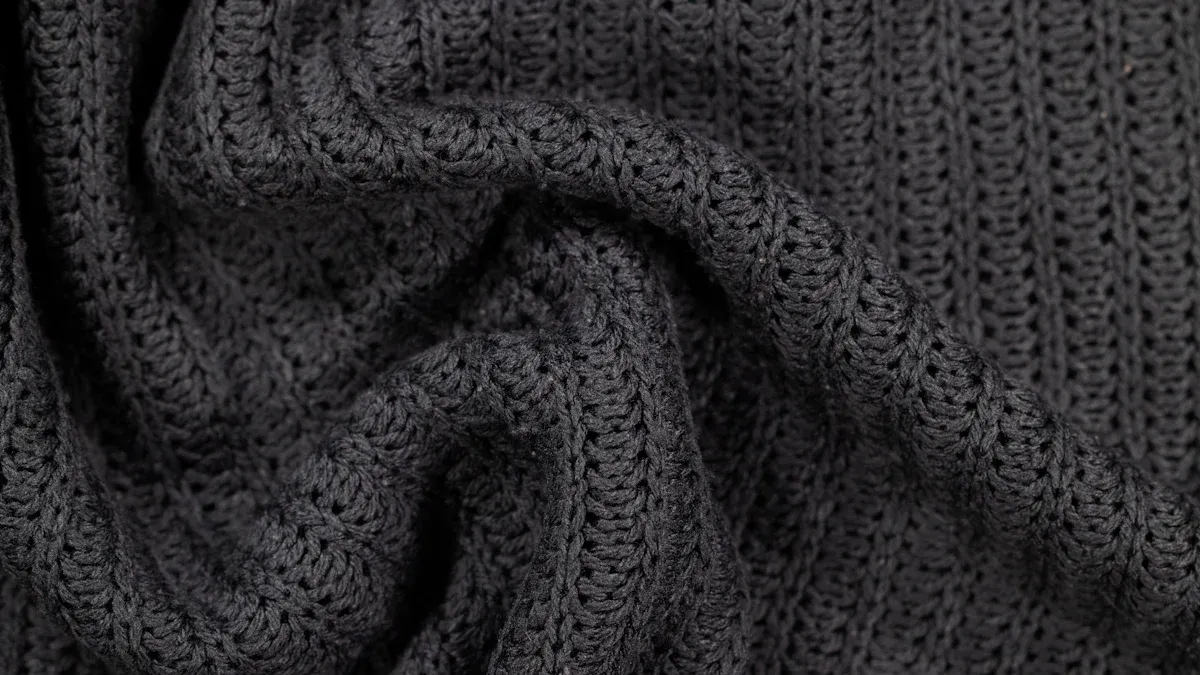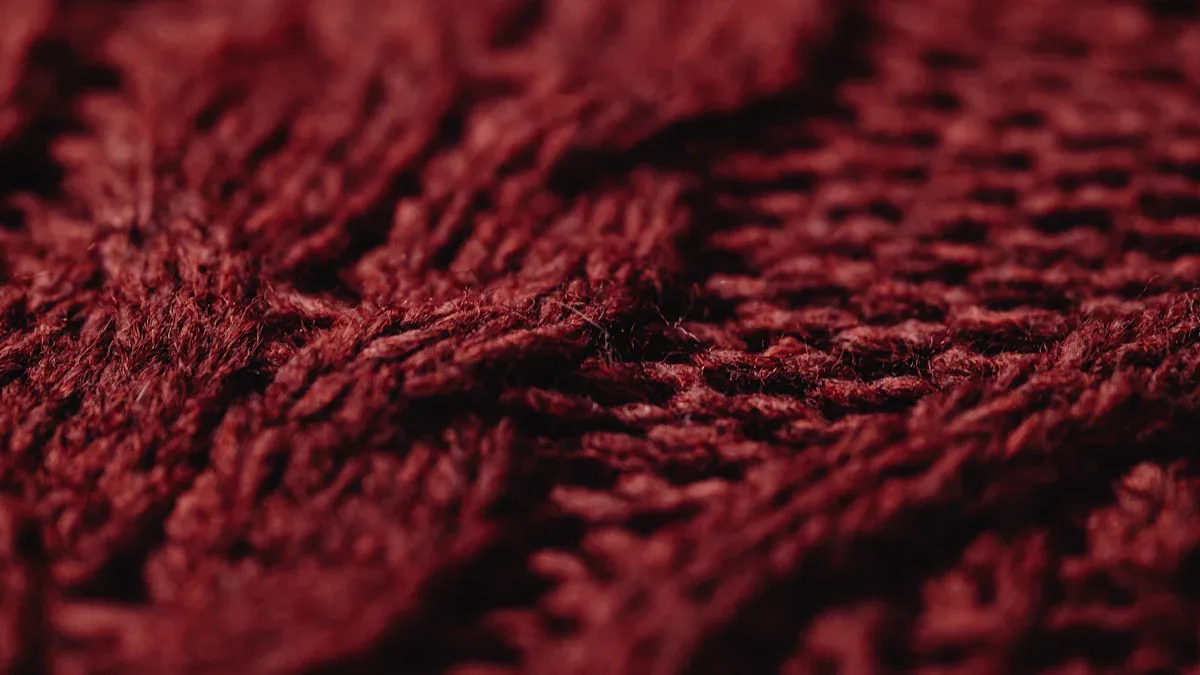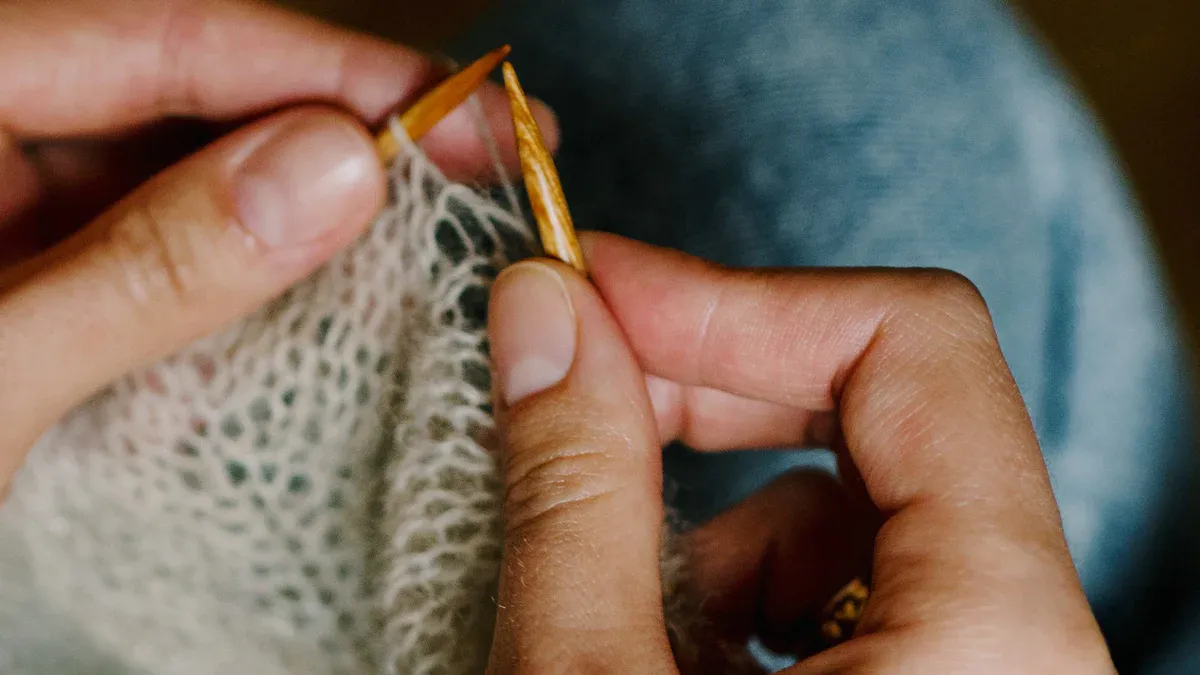
You might wonder, what is blocking knitting? Blocking helps you shape and finish your knitted pieces. When you ask what is blocking knitting, think of it as a simple step that changes how your project looks and feels. You soak or steam your work, then let it dry in the right shape. Blocking smooths out stitches and gives your project a neat look. Anyone can learn what is blocking knitting, no matter your skill level. Try blocking to see your knitting look its best!
Key Takeaways
Blocking helps your knitting look tidy and smooth. It makes the stitches even and sets the size.
Different yarns need different ways to block. You can use wet, steam, or spray blocking for the best look.
Blocking makes sweaters, lace, and other things fit better. It also makes the texture nicer by relaxing the fibers and fixing the edges.
Always be gentle with your knitting when you block it. Check the yarn care instructions so you do not ruin your work.
Simple tools like pins, mats, and blocking wires help shape your project. These tools make your project look neat and professional.
What is Blocking Knitting

Blocking Defined
When you finish knitting, you might notice your project looks a bit uneven or the edges curl. This is where blocking comes in. Textile experts describe blocking as the process of shaping your knitted fabric into the right size and form by adding moisture, steam, or a light spray of water. You use this step to set the stitches, smooth out the fabric, and fix any shape problems. Blocking helps your project look neat and professional.
You might ask, what is blocking knitting? It means you use water or steam to help your knitting hold its shape. You pin your work to the right size and let it dry. This step works for many types of yarn, like wool, silk, or cotton. Each fiber reacts differently, so you choose the best method for your yarn. For example, wool responds well to wet or steam blocking, while cotton needs gentle handling.
Blocking does more than just change the look. When you block your knitting, you relax the fibers. The loops in the fabric shift and settle into a new shape. The friction between these loops keeps the fabric in place, so it does not spring back to its old form. This means your project stays the way you want it, even after you remove the pins.
The Blocking Process
You can follow a few simple steps to block your knitting. Here is a basic guide:
Wetting: Soak your finished piece in lukewarm water. Use a gentle wool wash if you like. Squeeze out extra water without twisting the fabric. Roll it in a towel to remove more moisture.
Shaping: Lay your damp knitting flat on a blocking mat or towel. Gently stretch and shape it to the right size. Pin the edges in place using T-pins or rust-proof pins.
Drying: Let your project air dry completely. Do not rush this step. The fabric needs time to set its new shape.
Optional Steaming: For some fibers, you can use a steam iron with a damp cloth over the knitting. Hold the iron above the fabric and let the steam do the work. Do not press down.
Finishing Touches: After your project dries, remove the pins. Your knitting should now look smooth and even.
Tip: Always check the yarn label for care instructions before you start the blocking process. Some fibers, like acrylic, do not respond well to heat or moisture.
Blocking helps relax the fibers in your knitting. Wool, for example, becomes soft and flexible when wet. It holds the shape you pin it into as it dries. This makes the stitches even and the fabric smooth. Even if you use a wool wash without pinning, you will see your stitches look more even and less curled.
When you ask what is blocking knitting, remember it is a simple but powerful step. Blocking lets you shape your finished piece, even out stitches, and improve the overall look. You give your project a polished finish that lasts.
Why Blocking
Improves Shape
Blocking helps you get the right shape and size. When you finish knitting, it might look uneven or not fit. Blocking lets you stretch and smooth your project to match the pattern. You can use pins and mats to hold it while it dries. This step makes your knitting look neat and finished. Steam blocking is fast and works for many projects. It helps if you do not want to soak your work. Always check your yarn before blocking. Some fibers need gentle care. Blocking is very important for lace, sweaters, and things that need a certain shape. If you want your project to look great, blocking is the best way.
Tip: Try blocking on a small swatch first. This shows how your yarn acts and helps you avoid mistakes.
Evens Stitches
Blocking makes your stitches look smooth and even. Sometimes, your knitting has bumpy spots or puckers. Blocking relaxes the fibers and lets the stitches settle. This makes your project look tidy and neat. Many knitters see that blocking makes colors brighter and fabric softer. You can use wet, steam, or spray blocking. It depends on your yarn and project. Blocking also helps stop the edges from curling. This happens a lot in many patterns. If you want your stitches to match, blocking is important.
It helps set the shape of your project.
The process makes the yarn softer and fuller.
Blocking keeps the right size and fixes fabric problems.
Enhances Texture
Blocking shows off the texture in your knitting. Lace patterns open up and look pretty after blocking. Cables and textured stitches stand out more. This makes your work look special and detailed. The yarn you use can change how much your project changes. Slippery yarns and superwash wool may stretch more. Sticky wool keeps its shape better. Blocking wires and pins help you control the final look. Blocking can also clean your project. It removes oils and dust from the yarn.
Benefits of Blocking | Specific Blocking Techniques/Tools | |
|---|---|---|
Lace Projects | Makes patterns stand out and look nice | Use blocking wires, wet blocking, pin for shape |
Sets the size and fixes curled edges | Wet blocking, dry flat | |
Sweaters | Sets the size and fixes curled edges | Wet blocking to shape and set size |
Super Bulky Yarn Projects | Keeps the shape and structure | Use strong pins or blockers |
General Projects | Makes stitches even, lines up patterns, lasts longer | Pick the best method and tools for your yarn |
Blocking stops curling, opens lace, makes cables stand out, and removes puckers. You get a cleaner and better finish every time you block your knitting.
Blocking Methods

You can use different blocking methods to finish your knitting projects. Each blocking method works best for certain fibers and project types. The main methods are wet blocking, steam blocking, and spray blocking. You should always handle your work gently and avoid overstretching. Not every project needs blocking, but most benefit from it.
Wet Blocking
Wet blocking gives you the most control over shaping your project. You soak your finished piece in lukewarm water, then gently squeeze out the extra water. This method works well for wool and most natural fibers. You can follow these steps:
Cast off your item and weave in the ends.
Lift it out and gently squeeze out water without wringing.
Lay it on a towel and roll it up to remove more moisture.
Pin the damp piece to the right shape on a flat surface.
Let it dry completely before unpinning.
Wet blocking lets you stretch and shape your knitting. It takes longer to dry but gives the most dramatic results.
Steam Blocking
Steam blocking uses heat and moisture to set the shape. You pin your dry project to the right size, then hold a steamer or iron above it to release steam. This method works fast and gives crisp edges. Steam blocking is good for acrylic yarns, but you must be careful. Too much heat can melt the fibers and change the fabric forever.
Spray Blocking
Spray blocking is a gentle method. You pin your project to the right shape, then spray it with water until damp. This works well for delicate fibers that cannot handle soaking or heat. Spray blocking is quick and easy for small projects, but it does not reshape as much as other methods.
Recommended Blocking Method(s) | |
|---|---|
Wool | Wet blocking |
Cotton | Gentle wet blocking |
Acrylic |
When to Block
You should block sweaters, shawls, and lace projects to set the shape and even out stitches. Blocking is not always needed for socks or items that already look good. If you like how your project looks, you can skip blocking or just wash and dry it flat. Blocking swatches before starting a big project helps you avoid surprises in size or drape.
Tip: Always shape your project gently. Do not pull too hard or overstretch the fabric. Blocking helps your knitting look its best, but gentle handling keeps it safe.
Common Questions
Is Blocking Necessary?
You might wonder if blocking is always needed. The answer depends on your project and yarn. Blocking helps set the shape and size of your knitting. It makes lace patterns open up and sweaters fit better. Some projects, like garter stitch scarves, may not need blocking. Many knitters ask if blocking is needed for acrylic yarns. Acrylic does not respond like wool, but gentle steam or spray blocking can help smooth the fabric. Blocking is important for garments and lace, but not every item needs it.
Note: Blocking does not fix mistakes in your knitting. It helps stitches settle and shapes the fabric, but it cannot correct errors.
Will Blocking Damage My Work?
Blocking is safe when you use the right method for your yarn. Problems can happen if you use too much heat or stretch the fabric too far. For example, acrylic and nylon can melt if you use a hot iron. Cotton can shrink if you use hot water. Animal fibers like wool can felt if you rub or heat them too much. Always test blocking on a small swatch first. Use lukewarm water and mild soap. Pin your project gently and let it dry fully before removing pins.
Risk Type | How to Avoid Problems |
|---|---|
Use medium heat, keep iron above fabric | |
Stretching | Pin gently, avoid pulling too hard |
Shrinking | Use lukewarm water, test on swatch |
Felting | Avoid rubbing, use gentle heat |
Distorted Edges | Space pins evenly, use blocking wires |
Can All Yarns Be Blocked?
Not all yarns react the same way to blocking. Animal fibers like wool, alpaca, and cashmere block very well. They stretch, smooth out, and hold their new shape. Plant fibers, such as cotton and linen, do not stretch much. They keep their shape and need careful pinning. Acrylic yarns do not change much with blocking, but steam can help even out stitches. Always check your yarn label for care tips.
Animal fibers: Best for blocking, easy to shape.
Plant fibers: Less stretch, need gentle handling.
Acrylic: Needs gentle steam or spray, avoid high heat.
How Often to Block
You do not need to block every time you wash your project. Many knitters block once after finishing. Some items, like shawls or sweaters, may need blocking again after washing. If your project loses its shape, you can block it again. Blocking swatches before starting a big project helps you get the right size and fit.
Tip: Blocking is shaping, not stretching. Always handle your knitting gently for the best results.
Blocking gives your knitting a polished, professional look. Expert knitters say blocking smooths stitches, shapes your project, and opens up patterns. You can see big changes, like flat edges and even fabric, after blocking. Many knitters feel proud when they finish a project with this step. Blocking is easy to learn and safe for most yarns. Try blocking on your next project and enjoy the satisfaction of a job well done!
FAQ
How long does blocking take?
Blocking usually takes several hours to dry. You might need to leave your project overnight. The drying time depends on the thickness of your yarn and the room’s humidity. Always let your knitting dry completely before removing the pins.
Can you block acrylic yarn?
You can block acrylic yarn, but you need to use gentle steam or spray. Do not use high heat. Acrylic does not change shape as much as wool. Light blocking helps smooth out stitches and gives a neat finish.
What tools do you need for blocking?
You need a few simple tools. Use blocking mats, rust-proof pins, and a spray bottle or steamer. Blocking wires help with straight edges. These tools make it easy to shape your project and improve stitch definition.
Does blocking work for all knitting projects?
Blocking works for most projects. You see the biggest changes in lace, sweaters, and items with textured patterns. Some small items, like socks or hats, may not need blocking. Always check your yarn label for care instructions.









